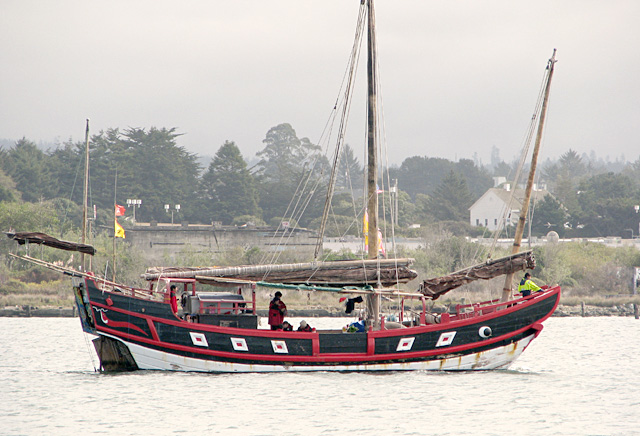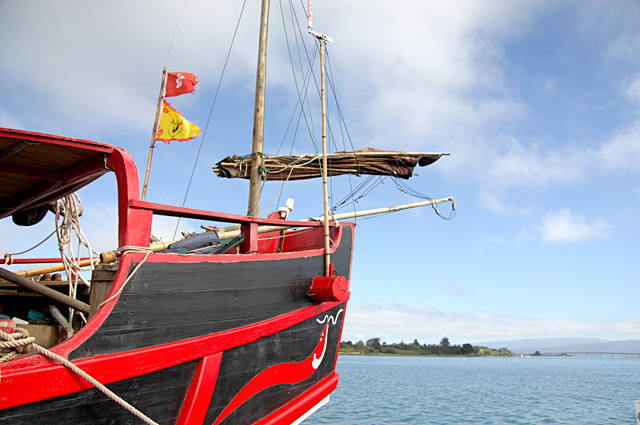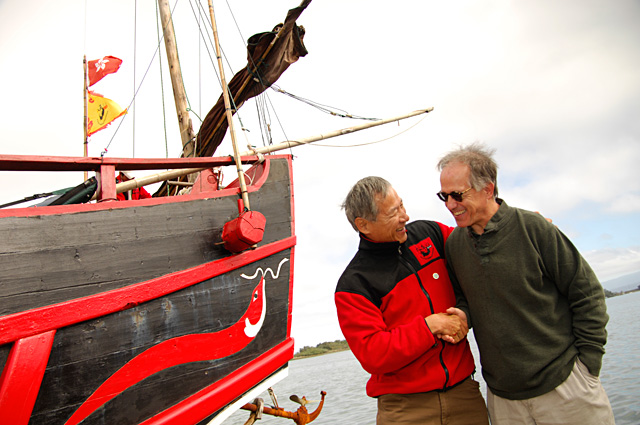
Christened the Princess TaiPing (meaningful peaceful), the boat is a replica of an ancient Chinese warship sailed by the famed Chinese mariner of the Ming Dynasty, Zheng He, who rode the waves from 1405 to 1433. He eclipsed Columbus and other Western explorers by decades with naval expeditions to nearly 40 countries, including Viet Nam and East Africa.
In 2006, Humboldt State hosted an international conference in Xi’an, China, that commemorated Zheng He and the University’s namesake, Alexander von Humboldt, another legendary explorer.
The conference familiarized many members of the HSU community with Zheng He. Dozens of them hastened to the Princess TaiPing replica to meet the eight-person crew and provide much needed assistance following the junk’s 69-day crossing from Japan to the West Coast, in tempestuous weather.
The skipper, Liu Ning Sheng, aka ‘Nelson,’ promptly dubbed the hospitality “The Eureka Smile.”
Scott Martin, Captain of HSU’s Research Vessel Coral Sea, eagerly greeted Liu and his seven shipmates. “I don’t know if anyone can truly appreciate the difficulty of what they have just accomplished,” Martin said. “Their journey across the Pacific and the conditions they endured are really a testament to their courage and will to recreate history. This voyage was really a matter of survival.”
An HSU oceanography class on the R/V Coral Sea was amazed at the sight of the junk and it dissolved their skepticism that Zheng He’s feats had preceded those of Columbus, according to Associate Professor of Oceanography Jeff Abell. To the students, he said, the Princess TaiPing looked more suitable for a nautical museum than a bold crossing of the planet’s largest ocean. “It didn’t take much more convincing that Zheng He could have easily made similar voyages with much larger ships more than 500 years ago,” Abell added.
The tiny sailboat is headed for San Francisco, then Hawaii and Wake Island. It is scheduled to reach Taiwan in April, weather permitting. It would afford Liu yet another world record, marking the first time a Chinese junk has sailed to North America and returned to the Pacific Rim. Liu was the first Chinese to circumnavigate the globe with a sailing boat, an adventure he named “The Hope Voyage: 2001.” It took two years and five months.

The Princess TaiPing derives its heritage from fuchuan, locally-built sailboats developed centuries ago in Fuzhou near mainland China’s Min River. Ming Dynasty (1368 to 1424) coastal patrol boats and warships were all fuchuan. They had high prows and a keel called “a dragon’s bone” that ran the length of the hull.
Liu’s 35-ton ‘junk’—from the Javanese jong, Malay adjong, Portuguese junco, Dutch junk—traces its earliest lineage to third-century Han Dynasty boats. The Princess TaiPing is a 15th-century design, its bow stub-nosed, its stern resembling a galleon’s. The junk is trimmed in bright red paint, a symbol of good luck in Chinese culture.
One of Liu’s key objectives was recovering centuries-old and nearly-lost shipbuilding techniques. There are no blueprints per se for the junks, although Liu and his associates tracked down important historical documents that guided the design and field research. The hunt for records began in 2004 and by 2006, a gathering of scholars and specialists was convened to patch over the lacunae.
Construction commenced in early 2007 and authenticity was its holy grail. Master shipbuilders guided sophisticated craftsmen from Fuzhou, Quanzhou and Zhangzhou. Carpenters wielded period-piece Ming axes and chisels to shape the junk’s materials, largely fir and acacia. Square shipbuilding nails, like those used a thousand years ago, hold the Princess TaiPing together.
The nearly 50-foot main mast was hewn from a Fuchou cedar that took months to locate and three days—and 10 men—to lug out of the forest.
China’s old shipbuilding techniques are recondite and obscure. Across the centuries, different carpenters’ families practiced varying approaches and much of what was known was lost. Disagreements broke out over the best techniques. The ranks of skilled craftsmen shriveled. Nevertheless, construction of the Princess TaiPing was based on historically accurate practices. It has no bolts, screws or synthetic resins. Traditional Chinese water sealant material was applied, but Liu freely confesses that his crew is usually wet and often soaked to the skin. “But they never complain,” he says. “They knew what they were in for.”
So authentic is the junk’s construction, Liu said, that the master shipbuilder declined to pronounce it seaworthy. But it proved so on its first monumental sojourn across the roiling Pacific. Skipper and crew encountered stormier weather than they anticipated, but the Princess TaiPing proved stout and agile.
Liu underscored how labor intensive a wind-powered junk is. In hectic weather, three deck hands are needed to control the primitive, pulley-operated rudder. Even in calm weather, his sailors are busy all the time. What is the biggest difference between his junk and a 2lst century boat (other than high tech navigation and communications equipment)? A modern sailboat is easily maneuvered by a lone pilot.
The Princess TaiPing mission is the offspring of Taiwan’s Chinese Maritime Development Society. Skipper Liu spelled out three major objectives: recovering and preserving ancient Chinese shipbuilding and navigation techniques; sharing Chinese maritime culture with the West; and promoting mutual East/West understanding and cultural appreciation.
“I have loved the ocean since I was a little child,” says the former chairman of the Taipei Sailing Association. “We must awaken the Chinese and other peoples of the world to our culture of seafaring and shipbuilding. The people I meet move my heart, move my soul, and give me the touch of their culture.”
Liu, who rejects the titular rank of captain—“I’m slave of the yacht,” he grins—sees himself as an ambassador of peace, following in Zheng He’s wake.
China marked Zheng He’s 600th anniversary in 2005 and among other things the celebration was intended to build awareness of Asia’s precedent-setting role in pre-Columbian maritime exploration, which many Asians believe has been neglected by historians.
Nelson Liu views his junk as a practical cultural link between East and West, two civilizations, he notes, that have alternately romanticized and demonized each other for millennia.

HSU Education Professor Thomas Cook first met Liu in Taipei, Taiwan’s capital, in 1975. They remain firm friends—they once sailed together from San Francisco to Los Angeles in the early 1990s in a 29-foot craft—and Cook portrays the Taiwanese skipper as a man “who will roll the dice and risk everything to achieve his dreams. And he’s a leader. Look how he gets these crew members to follow him, not even being paid!”
In a dockside interview Oct. 6, Cook laughed and joked with his Taiwan mate in a happy reunion, and they posed together for pictures on the 54-foot long Chinese junk (the deck is a mere 45 feet in length) that is entirely wind-powered.
Cook exclaimed, “If I didn’t have to teach classes, I’d sail back to Taiwan with him. He’s got one more space for a crew member!”